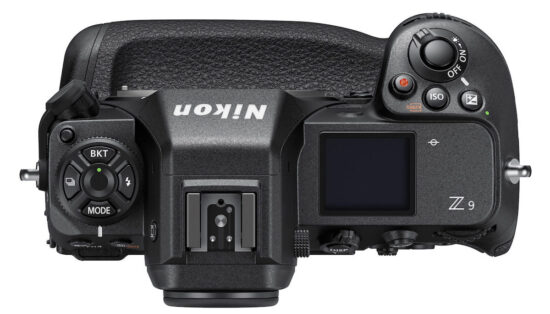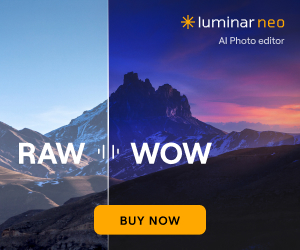Nikon Z9 first impressions by Wade Tregaskis (see also this related post) based on camera firmware 1.11.
All example photos are straight out of the camera from High Efficiency* raws as rendered by Lightroom. Some are cropped where appropriate.
Ergonomics
- You cannot use the camera at all – can’t even bring up the menus – if you have a “stowed” lens attached, like the 24-70/4 in compact form. This is not a big deal, of course, but it’s annoying that you can’t do anything with the camera and it doesn’t give any indication why – unlike the Z7, the Z9 doesn’t turn on the LCD in this situation, only the EVF, so it’s very easy to miss the dialog it’s trying to show that’s complaining about the lens.
- It took a little experimentation to figure out how to manipulate the LCD screen easily. If you just grab the side and try to pivot it up or down, for example, it’s almost impossible to do so without fear of breaking something. This seems to be a consequence of its complicated multi-levered design. Fortunately Nikon have included little grabbers on the top & bottom as well, and if you use those appropriately the screen is easy enough to position.
- With the Sigma 150-600 Contemporary attached, I’m finding the Z9 isn’t significantly different in weight from the Z7 (or D500). I also don’t see any meaningful difference in “balance” or any such thing that apparently lots of other people do.
- One thing I hadn’t really considered is that the Z9 is a rounded square, whereas the Z7 was a less rounded rectangle. Consequently the Z9 likes to roll about, such as in a car going around corners, which is annoying – on a recent windy-road drive I had to hold the Z9 the entire time, in my lap, to prevent it attempting to commit suicide against the doors and dashboard.
- Some camera harnesses are problematic with the Z9, unless you have a tripod foot on the lens that you can attach to instead.e.g. my preferred camera harness is a Cotton Carrier, but the Z9’s big fat butt forces the camera and lens to stick out way more, which puts a lot more torque on the harness – I worry it’ll eventually snap from the stress – and is just less comfortable all round.
Performance
Autofocus
It hasn’t completely kicked the Nikon Z habit of obsessive-compulsive behaviour regarding backgrounds. Sometimes with a clear subject front-and-centre, right there in the middle of the frame, it’ll buck all artistic conventions and seek novel compositions in the background.This is rare, to be clear. The Z7 did this all the time. I think the Z9’s only really done it once, maybe twice so far. So I wouldn’t call this a big deal, even though it’s such an obvious fail when it happens. Still, it’s a bit sad that Nikon still can’t seem to figure this out.
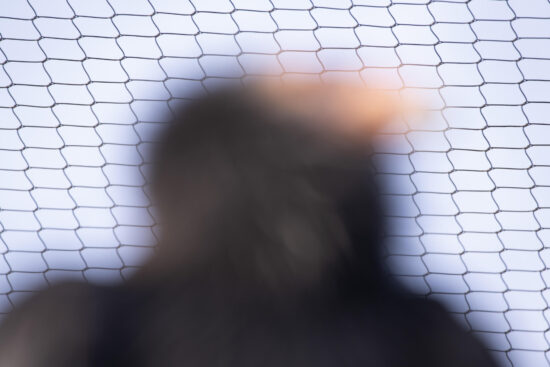
California Condors have a wing span of nearly three metres. This makes them very hard to spot, clearly.
As others have occasionally commented in reviews, eye autofocus is easily foiled if the eye is obstructed at all, e.g. by hairs, feathers, or similar. In most cases (that I’ve seen so far) it will vacillate randomly between the eye and the obstruction.As such, it is possible to still get the eye in focus, but you need to take a lot of pictures and hope for the best.This is not unique to subject-detecting AF modes – the problem occurs in single-point AF as well, for example.This behaviour in single-point mode is justifiable – in abstract there’s no way for the camera to tell which of the possibilities you actually want – but I would think that when it explicitly detects an eye it would understand how to avoid common obstructions like hairs & feathers, and similarly nearby elements like eyelashes. e.g. focus specifically on circular or oval features, or simply always prefer the furthest detected feature. Alas it does not.
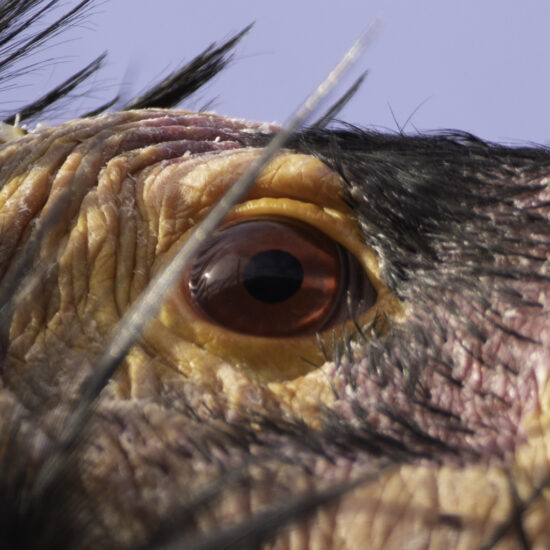
For reference, Nikon, this is what an eye looks like.
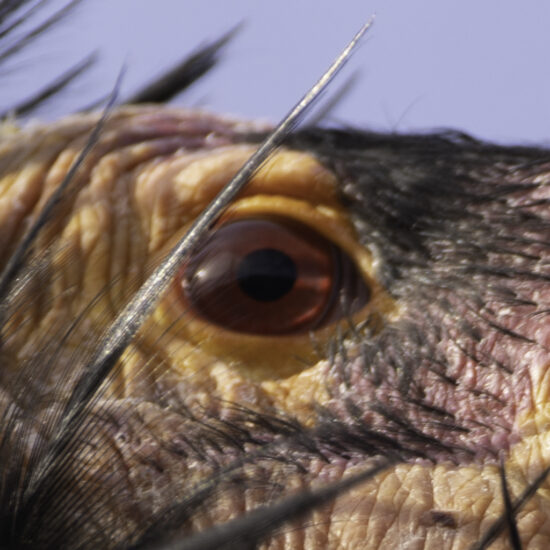
This, on the other hand, is a feather. Notice the subtle distinction in how they look nothing alike.Eye detection is sometimes wrong about what is an eye – e.g. nostrils on birds. I don’t have much data on this yet, but I get the initial impression that it’s basically just looking for a roundish feature that is darker than its surroundings, and nostrils are often darker than eyes (since eyes often have reflections and/or colour irises), or the eyes might be partially obscured. The behaviour is dependent on the bird – e.g. for California Condors it was a real bugger sometimes in trying to get it to recognise the actual eye, but for many other bird species it had no issues.

All AF modes using subjection detection – e.g. auto-area, 3D tracking – were very insistent about picking the nostril as an “eye”, ignoring the actual eye that is clearly visible. I had to switch to single-point AF to get usable focus.
For some animals – e.g. this California Condor which is apparently the Z9 AF system’s nemesis – it doesn’t recognise the actual face at all, but frequently thinks it sees a face elsewhere on the animal. In poses like the one above it mistook the nostril for an eye and prioritised that, but in the photo below it didn’t detect any eyes and instead thought it saw a face in the middle of those neck feathers.
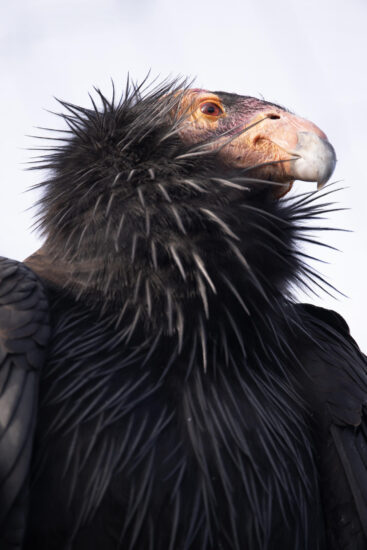
Once again I had to switch to single-point AF in order to get usable focus, as otherwise it would stubbornly focus only on the neck feathers.
Similarly in some cases it doesn’t recognise an obvious animal at all, but thinks it sees something interesting in inanimate objects. This is compounded severely by the design flaw where 3D tracking mode will always focus on any detected subject no matter where you tell it to focus, and disabling subject detection (to work around this flaw) requires menu-diving.
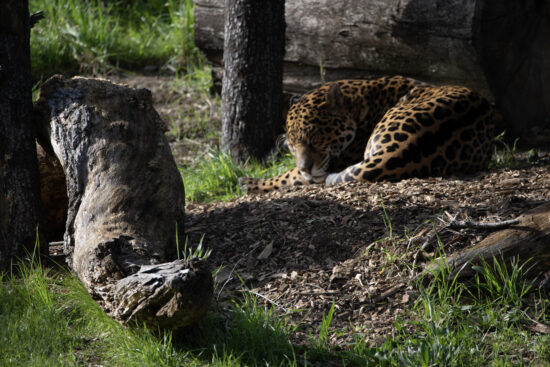
Rumours of leopards in this photo are greatly exagerated, according to the Z9. Fortunately there’s a fascinating log that simply must be photographed. Disclosure: I leaned into its silliness and framed this example photo deliberately, but to be clear it would not see the leopard at all until I zoomed in significantly closer, and it consistently saw the log as a subject even when it was only just visible at the edge of the frame.
I’ve seen a small number of cases where the camera simply front-focuses for no apparent reason, in single-point AF. Sometimes it’s so severe that nothing in frame is in focus. This is with the 24-70/4 at least. When this happen it consistently misses focus across all photos in a burst (with AF-C active).To be clear, usually the camera focuses consistently on at least something in the scene – especially with single-point AF it’s generally very reliable. Just not always.
I haven’t tested it properly yet, but I get the impression the Z9 suffers from the same flaw as the Z7 regarding autofocus performance vs exposure preview. i.e. if your subject is dim in the viewfinder – because you have accurate exposure preview enabled and you’re under-exposing (e.g. it’s an inherently dark subject, or you’re protecting highlights, etc) – the autofocus system performs worse. Simply raise the ISO, for example, and autofocus works much better (but now your actual exposure is wrong, and your photo might be unusable).This is probably why Nikon have the “View mode (photo Lv)” setting (Custom Settings > Shooting/display > d9), so that you can choose which of these trade-offs you wish to prioritise. But with accurate preview turned off it’s all too easy to screw up the exposure, especially in non-trivial lighting situations where the rudimentary exposure meters just can’t convey what’s going on.DSLRs didn’t have this issue per se because they had no exposure preview mode – and because the AF system was separate from the image sensor, the AF system could always operate with whatever settings it found optimal.The crux of my frustration is that it feels like a false dichotomy. I don’t understand why it can’t use whatever ISO is best for AF, but simply adjust the image in the viewfinder to compensate. e.g. if it needs a few extra stops of gain for good AF, then just reduce the EVF / LCD preview by the same amount. Sure, it might clip highlights in the EVF preview, but I think I’d prefer that – the highlights would still be fine in the actual photos taken, and in any case if the subject isn’t in focus blown highlights are irrelevant.
Image stabilisation
I’m seeing particularly poor image stabilisation performance with the Sigma 150-600 Contemporary. This lens has always had poor image stabilisation, on the Z7 and the D500. But I feel like it’s worse on the Z9.If I want the majority of hand-held images to be usably sharp at 600mm, it seems like I have to use a shutter speed of at least 1/500. I haven’t really established a baseline by turning image stabilisation off, but I can’t see how 1/500 equates to more than a stop or two of effective stabilisation, at best.Most of my favourite wildlife photos are taken in the range of 1/10 to 1/100, so this is a big problem for me.I’m also seeing more (vs the D500, Z7, etc) of the behaviour where the vast majority of photos are unusably blurry and then just occasionally one is actually sharp. There’s not a lot of middle ground. I mention this because with e.g. Nikon’s own 80-400 or the 100-400 you tend to get a much smoother continuum of blurry to not blurry.It’s the only non-Nikon lens I use with its own image stabilisation, so I can’t draw any conclusions as to whether this is first- vs third-party lens compatibility or anything like that.
Metering
Ever since it was introduced (D500 era, I think?) I’ve used highlight-weighted metering almost exclusively in stills photography, because noisy midtones can be mitigated but blown highlights can be ruinous. But with the Z9 I found very quickly that it would massively under-expose sometimes in highlight-weighted mode. I switched to matrix metering and have almost exclusively used that so far. It works well most of the time, but of course it does sometimes blow the highlights.
If “Starlight view (photo Lv)” is enabled (Custom Settings > Shooting/display > d9), the EVF / LCD do not show exposure accurately, irrespective of the setting of “View mode (photo Lv)”. This is extremely surprising and caused me to massively over-expose a bunch of images.It makes me suspect that “starlight” mode – which is nominally about autofocus working better in low-light – is nothing more than forcing the sensor into ISO settings that are most amenable to the autofocus system rather than representative of the intended exposure (see earlier point about AF effectiveness vs exposure preview).
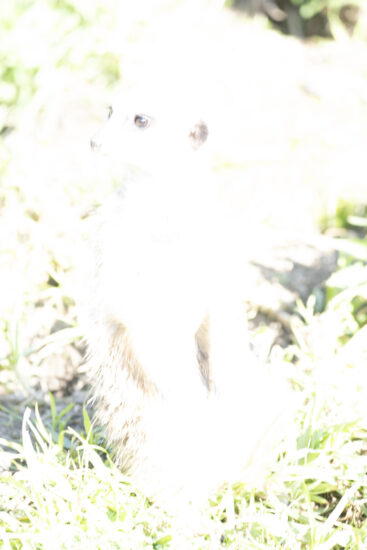
This full-body portrait of a naked meerkat is apparently too saucy for the Z9, and must be censored.
Battery life
The battery lasts about six hours in my use. That’s with the camera on the whole time, GPS enabled (with standby turned off), and sporadic use in 20 FPS mode.Battery life seems to be mostly affected by how long the camera is switched on and especially how long the EVF or LCD are active. How many photos you take doesn’t seem to be a significant factor. Though video might (I haven’t done a lot of video yet).I assume the GPS is a significant power suck. Previously, on my Z7, I used a Solmeta GMAX hotshoe GPS because (a) it has a big internal battery that avoids draining the camera’s battery, (b) it was far more reliable than any other GPS unit I ever tried, and (c) having its own battery meant it could keep active irrespective of what the camera was doing or whether the camera was even on. I could use that on the Z9 too, but the combination would be too big for my tastes. If you’re not going to use the built-in GPS you’ll probably see a significant increase in battery life.I could also turn the camera off between use, which might save a significant amount too – but I’m afraid to do that because I’m not convinced the GPS will work as reliably (the Z9’s manual claims the GPS will continue tracking even if the camera’s off, but frankly I’m sceptical based on past experience with earlier cameras & GPS units).On the Z7 I’d usually get at best four hours per battery, and that’s even though I’d turn the camera completely off when not actively using it. So it’s clear the Z9 gets significantly better battery life – as you’d expect given it has 157% more capacity.For a long day of use, or if recording significantly amounts of video, you’d definitely need at least two batteries for the Z9 (or rely heavily on USB tethering).
Battery charging in-camera officially takes 3h 40m from 0% to 100%, and I haven’t tried to precisely measure that but it seems about right for what I see in practice.Using a USB battery brick to charge the camera seems to add about 2% every five minutes or so. If you’re out for the day and take a half hour lunch break, for example, you can only add ~12% more juice to the battery. Not all that useful. I find having a USB cable sticking out the side of the camera to be dangerous to the camera’s health (cable yanks, water ingress, etc) so power / charging while it’s in use doesn’t seem practical to me.I haven’t tested it yet, but in theory you can use any old USB power source to charge a second battery, which will be super helpful (compared to having to use mains power as with previous Nikon battery chargers).I’d really like to see future Nikon cameras & batteries support faster charging, like most portable electronics do. e.g. USB-PD 60W should be enough to goose the battery from 20% to 80% in just twenty minutes. That’d make it real easy to have a single battery and just top it up every time you take a bathroom break or whatever.
Reliability
Crashes
It locks up occasionally in playback mode, when reviewing images. It’ll suddenly just stop responding to all controls, and after fifteen seconds it reboots itself. It forgets everything it was doing when it reboots (e.g. the playback image position resets to the most recently recorded image).
GPS
The GPS seems to work quite well so far, though I’ve basically just been moving to a location, preparing, then taking photos, then moving on – a more challenging test will be if I’m moving while taking photos, such as on a boat, or taken photos suddenly after moving. Those are situations in which a lot of GPS units / Nikon cameras will make mistakes, like recording wildly stale location data.
I’ve taken a bit over a thousand photos so far, with GPS enabled.
- Once it’s acquired its position it seems to update it every second, as you’d expect.
- It does actually work indoors (all the time so far for me, but I haven’t been indoors much). This is a pleasant surprise. Some prior GPS units I’ve used have basically not worked at all indoors.
- It seems to be much more capable of actually acquiring an accurate position – when faced with obstructions etc – than most prior GPS hotshoe units I’ve tried, though I’d be [very pleasantly] surprised if it matches the Solmeta GMAX in that regard.
- It’s never failed to record the location so far.
- It’s never gotten the location completely wrong, so far.It’s not super accurate, though – I see longitude and latitude inaccuracies of up to ~ten metres in some cases. It’s good to just a couple of metres most of the time, though. The Solmeta GMAX is more consistently accurate, but for my purposes ~ten metres of error – occasionally – isn’t a big deal.Altitude isn’t accurate – its regularly off by tens of metres. e.g. at the beach yesterday it consistently thought I was 12 to 19 metres below sea level.
- Even with all the standby stuff disabled and the camera left on at all times, it does lose its position if you’re not actively using the camera (according to the position read-out in the menus). That concerns me, as this mimics the behaviour of most prior [hotshoe] GPS units with Nikon cameras, and my experience with them is that they fail to correctly tag photos a lot. But, as noted above, so far it’s actually worked well despite this.I have not yet tried enabling GPS logging – presumably that forces the camera to maintain an accurate GPS location at all times. So that might be a workaround, if there are any issues.
- It doesn’t record heading like the Solmeta GMAX, but then to be honest magnetic compasses tend to be uselessly inaccurate anyway so I’m not really missing that (though if it had it, and it worked reliably, that would be nice).
- There’s no way to tell at a glance if the camera actually has a GPS location fix. There’s a satellite icon that shows up in various places in the GUI, but all it seems to mean is that GPS is enabled, not that it actually has a location lock.You can dig into the menus to find out, but that’s a bit slow.I miss the built-in LCD of the Solmeta GMAX where I could see at a glance if it had an accurate position fix. Maybe Nikon could issue a firmware update that adds a little satellite count badge to the satellite icon, like most GPS units display – I find that’s a good-enough proxy for accurate location data.
Software support
Just a minor oddity, but Lightroom’s Import dialog seems to have problems with High Efficiency NEF files – it won’t reliably show thumbnails for them. You can “jostle” it by mousing over the blank spaces to get it to load the thumbnails, most of the time, but this isn’t something that’s required for Nikon NEF files from earlier cameras.
Nikon Z9 pre-orders links:
| Z9 pre-orders (US): | Europe | Canada |
| Adorama B&H Amazon Pauls’s Photo Service Photo | Calumet (NL) Calumet (DE) Foto Erhardt (DE) Foto Koch (DE) WEX (UK) | CameraCanada |

